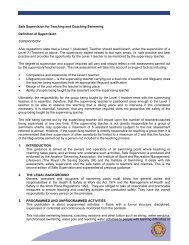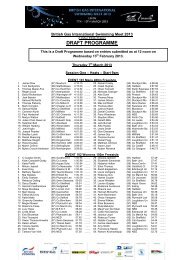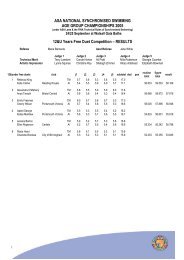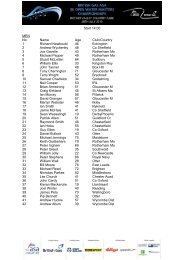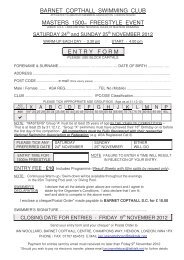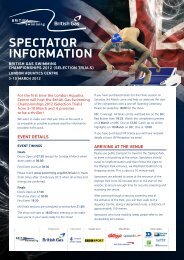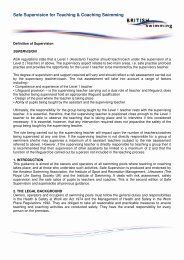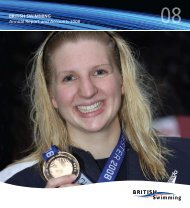Inclusion of Swimmers with a Disability - Swimming.Org
Inclusion of Swimmers with a Disability - Swimming.Org
Inclusion of Swimmers with a Disability - Swimming.Org
Create successful ePaper yourself
Turn your PDF publications into a flip-book with our unique Google optimized e-Paper software.
Overview <strong>of</strong> a variety <strong>of</strong> conditions<br />
A brief outline <strong>of</strong> some <strong>of</strong> the more<br />
common medical conditions likely to be<br />
encountered is listed below, together<br />
<strong>with</strong> some additional observations.<br />
Achondroplasia (Dwarfs)<br />
In the majority <strong>of</strong> cases this a genetic<br />
condition <strong>with</strong> people having restricted<br />
growth.<br />
l Attention may be needed to achieve<br />
balance and initial safe body position.<br />
l Once water confidence and controlled<br />
breathing have been achieved, move<br />
towards a conventional swimming<br />
technique.<br />
Arthritis<br />
Osteoarthritis – this is due to wear and<br />
tear on joints particularly hips and knees.<br />
Rheumatoid – this is a hereditary<br />
condition causing inflammation <strong>of</strong> joints.<br />
Can affect any age group. Also known<br />
as Stills disease in children.<br />
l Sculling is very useful in the early<br />
stages as it causes less pain and<br />
propulsion can be gained using<br />
minimum effort.<br />
l Breathing is easier when supine<br />
(on back).<br />
Arthrogryposis<br />
Due to a congenital condition<br />
from birth. It causes multiple joint<br />
contractures and is characterised by<br />
muscle weakness.<br />
l Weight bearing is possible but<br />
movement is limited by tightness <strong>of</strong><br />
the joints.<br />
Cerebral Palsy<br />
This is due to an oxygen deficiency at<br />
birth or during an accident that may<br />
result in some <strong>of</strong> the difficulties listed<br />
below.<br />
l Reduced muscle power.<br />
l Increased muscle tone, causing stiff<br />
flexed limbs (spastic).<br />
l Difficulty in breath control and<br />
swallowing.<br />
l Involuntary, uncontrolled movements<br />
– uncoordinated (atheoid).<br />
l Disturbance <strong>of</strong> balance (ataxic).<br />
l Possible speech problems.<br />
l Possible cognitive impairment.<br />
There are three types <strong>of</strong> Cerebral Palsy<br />
<strong>with</strong> further descriptions that describe<br />
limbs affected.<br />
Spastic<br />
l Increased muscle tone making limbs<br />
appear stiff.<br />
Athetoid<br />
l Co-ordination is poor because <strong>of</strong> the<br />
involuntary movements and many may<br />
appear clumsy. However symmetrical<br />
movements are easier to learn.<br />
l Breathing difficulties may be apparent.<br />
Ataxic<br />
l The individual may lose balance<br />
<strong>with</strong>out prior warning.<br />
Medical descriptions <strong>of</strong> cerebral palsy<br />
may include:-<br />
Quadraplegic - both legs and arms are<br />
involved. The individual may be in a<br />
wheelchair if severely affected.<br />
Diplegic - legs affected more than arms.<br />
Tend to walk on toes <strong>with</strong> knees turned<br />
or rotated inwards. May/may not use<br />
wheelchair.<br />
Hemiplegic - either left or right side <strong>of</strong><br />
body involved. <strong>Swimmers</strong> who have had<br />
a stroke may be considered in the same<br />
way.<br />
Dysmelia/Amputees<br />
Dysmelia is congenital from birth,<br />
amputee is acquired as a result <strong>of</strong><br />
trauma/accident.<br />
l Affected limbs may require protection<br />
especially if new. Be careful not to<br />
bang them accidentally.<br />
l The swimmer may need to remove a<br />
prosthesis (artificial limb) close to the<br />
poolside.<br />
l Individuals <strong>with</strong> lower limb loss should<br />
establish a safe means <strong>of</strong> moving<br />
around the poolside.<br />
l Individuals may take longer to achieve<br />
balance.<br />
Achrondroplasia<br />
5



